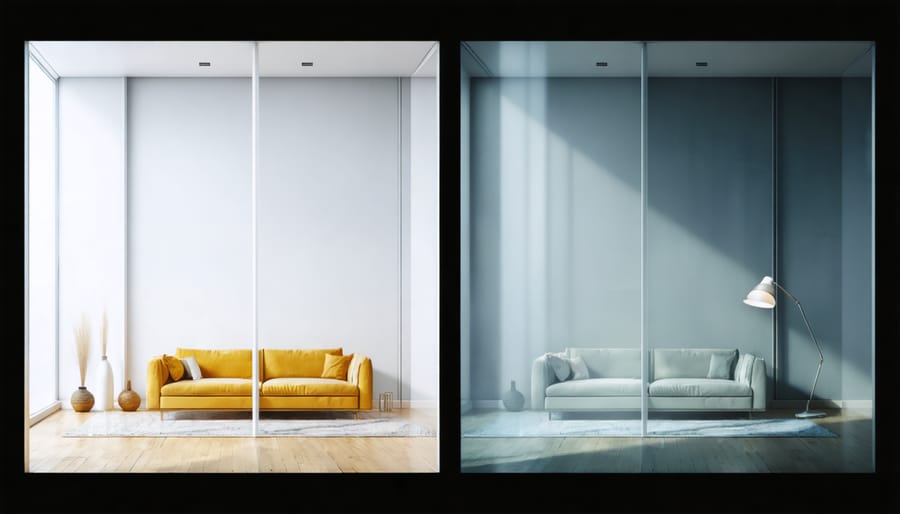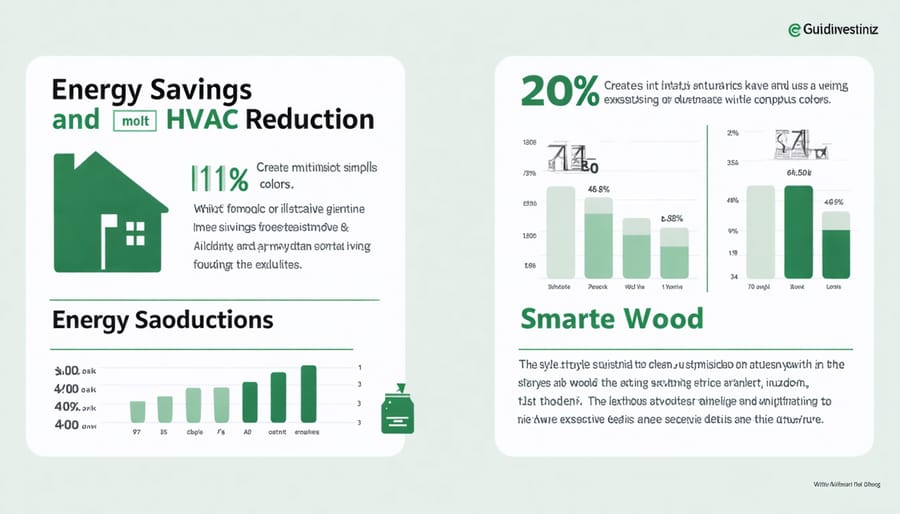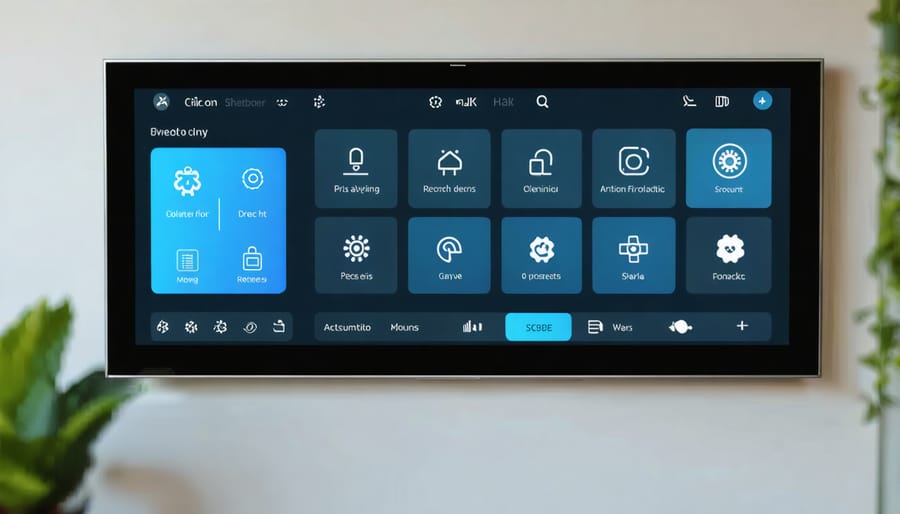Smart windows represent a revolutionary approach to energy-efficient home design, offering an elegant solution to reduce heating and cooling costs while enhancing living comfort. These innovative glass installations automatically adjust their tint based on sunlight intensity and indoor temperature, effectively managing solar heat gain throughout the day. By blocking up to 95% of harmful UV rays during peak hours and allowing natural light during cooler periods, smart windows can slash energy bills by 20-30% annually. Beyond the immediate energy savings, they eliminate the need for traditional window treatments, seamlessly integrating with modern home automation systems to create a more sustainable living environment. This technology represents just one example of how thoughtful design choices can dramatically impact both our carbon footprint and monthly utility expenses.
Understanding Smart Window Technology
Dynamic Glass Technology
Dynamic glass technology is revolutionizing how we think about windows and energy efficiency. Imagine windows that automatically adjust their tint based on sunlight or temperature – that’s exactly what electrochromic and thermochromic glass options offer. These smart windows use advanced materials that change their properties to control heat and light transmission throughout the day.
Electrochromic glass operates like a giant pair of transition lenses for your home. When an electrical current passes through the glass, it triggers a chemical reaction that changes the window’s opacity. You can control these windows manually through a smartphone app or set them to respond automatically to lighting conditions.
Thermochromic glass, on the other hand, responds directly to heat. As temperatures rise, the glass naturally darkens to reduce solar heat gain. When it’s cooler, the glass returns to its clear state, allowing more natural light and warmth to enter your space.
Both technologies can significantly reduce your cooling costs in summer and heating expenses in winter. While the initial investment might be higher than traditional windows, the long-term energy savings and improved comfort make them an increasingly popular choice for energy-conscious homeowners.

Smart Control Systems
Smart control systems are revolutionizing how we manage energy in our homes, making it easier than ever to reduce consumption without sacrificing comfort. These intuitive systems combine sensors, automated controls, and user-friendly apps to create a seamless energy-saving experience.
Motion sensors automatically turn lights off in empty rooms, while smart thermostats learn your schedule and adjust temperatures accordingly. Many systems allow you to control your home’s climate and lighting from your smartphone, ensuring you never waste energy when you’re away.
The real magic happens with smart scheduling features. You can program your heating to warm up just before you wake up and cool down when you’re at work. Some systems even track local weather patterns and adjust accordingly – for instance, closing motorized blinds on hot days to reduce cooling needs.
For the tech-savvy homeowner, these systems can integrate with voice assistants and create custom “scenes” for different activities. A “movie night” setting might dim the lights and lower the temperature, while “good morning” could gradually brighten rooms and warm up the house – all while optimizing energy use.
Energy-Saving Benefits

Climate Control Efficiency
Smart windows are revolutionizing how we manage indoor climate control, offering a sophisticated yet practical solution for reducing HVAC energy consumption. These innovative windows automatically adjust their tint based on sunlight intensity and indoor temperature, effectively managing heat gain and loss throughout the day.
During summer months, smart windows darken to block excess solar heat, reducing the workload on your air conditioning system. Studies show this can cut cooling costs by up to 25%. In winter, the windows maintain clarity to welcome beneficial solar heat, supporting your heating system and lowering energy bills.
What makes these windows particularly efficient is their responsive nature. Using electrochromic technology, they react to changing conditions without requiring manual adjustment. On bright, hot days, they automatically darken to prevent heat buildup, while on cooler days or during evening hours, they remain clear to maximize natural light and beneficial heat gain.
The impact on HVAC efficiency is substantial. By reducing solar heat gain in summer and heat loss in winter, smart windows create a more stable indoor environment. This stability means your heating and cooling systems don’t have to work as hard to maintain comfortable temperatures. Many homeowners report seeing a noticeable decrease in their HVAC runtime after installation, with some systems cycling up to 30% less frequently.
For optimal results, smart windows work best when integrated with your home’s existing climate control systems, creating a coordinated approach to temperature management.
Light Management Benefits
Natural light is one of our most valuable resources for creating comfortable, energy-efficient spaces. Smart windows excel at maximizing daylight while minimizing energy waste, offering a perfect balance between illumination and efficiency.
During bright daylight hours, these windows automatically adjust their tint to let in just the right amount of natural light. This reduces the need for artificial lighting while preventing glare and excessive heat gain. In office spaces, this can mean significant savings as overhead lights can remain off or dimmed during peak daylight hours.
The system’s ability to respond to changing light conditions throughout the day means you’ll rarely need to adjust blinds or curtains manually. On cloudy days, the windows maintain maximum transparency to ensure adequate natural light penetrates your space. As evening approaches, they gradually transition to allow more light in, compensating for the declining daylight.
This smart management of natural light doesn’t just save energy – it creates a more pleasant living or working environment. Studies show that proper natural lighting improves mood, productivity, and overall well-being. By reducing dependence on artificial lighting during daylight hours, you’re not only cutting energy costs but also creating a more sustainable and comfortable space that works in harmony with nature’s own lighting cycle.
Installation and Integration
Retrofit vs. New Construction
When it comes to implementing energy-saving designs, you have two main paths: retrofitting your existing space or incorporating them into new construction. Each option has its own set of possibilities and considerations.
Retrofitting existing buildings offers immediate opportunities for energy savings without the need for complete reconstruction. You can start small by updating windows, adding insulation, or installing smart thermostats. These upgrades are typically less expensive than new construction and can be done gradually as your budget allows. Plus, you’ll see energy savings right away while preserving the character of your current space.
New construction, on the other hand, allows for comprehensive energy-efficient design from the ground up. You can optimize everything from building orientation to material selection, creating a highly efficient structure from day one. This approach often leads to better long-term performance and can incorporate advanced features like passive solar design or geothermal heating systems.
For most homeowners, the choice between retrofit and new construction comes down to current circumstances. If you’re happy with your location and basic home structure, retrofitting makes sense. But if you’re planning to build new or undergo major renovations, incorporating energy-saving designs from the start can maximize your long-term benefits.
Smart Home Integration
One of the most exciting aspects of smart windows is their seamless integration with smart home automation systems. Imagine your windows automatically adjusting their tint as your thermostat detects temperature changes, or working in harmony with your lighting system to maintain optimal indoor brightness throughout the day.
By connecting your smart windows to your home’s central hub, you can create custom schedules that maximize energy efficiency. For instance, during summer months, your windows can automatically darken during peak heat hours while simultaneously adjusting your AC settings. In winter, they can maximize natural light and heat gain during sunny days, reducing the need for artificial heating.
Voice control through popular assistants like Alexa or Google Home adds another layer of convenience, allowing you to adjust window settings with simple commands. Many systems also offer smartphone apps that provide real-time energy usage data and savings reports, helping you track the impact of your smart windows on your energy bills.
The best part? Most modern smart window systems are designed with user-friendly interfaces, making it easy to set up and customize automation routines without technical expertise. You can start simple and gradually add more sophisticated features as you become comfortable with the technology.

Cost Considerations and ROI
When considering energy-saving design features, it’s essential to understand both the initial investment and the potential energy savings and cost benefits over time. Smart windows, for instance, typically require an upfront investment of $50-100 per square foot, which might seem substantial at first glance. However, these innovative solutions can reduce energy costs by 20-30% annually, paying for themselves within 5-7 years.
The ROI calculation isn’t just about direct energy savings. Consider the increased property value, which typically rises 3-5% with energy-efficient upgrades. Plus, many regions offer tax incentives and rebates that can offset initial costs by 10-30%, making the investment more attractive.
To maximize your return, start with a home energy audit to identify the most impactful improvements. Focus on high-traffic areas first, where energy-saving features will have the greatest effect. Remember that combining multiple energy-saving solutions often creates a multiplier effect on your savings.
Keep in mind that maintenance costs are generally minimal, requiring only routine cleaning and occasional system checks. Many manufacturers offer warranties of 10-15 years, providing peace of mind for your investment. While the initial costs might feel daunting, the long-term financial benefits, combined with increased comfort and environmental impact, make energy-saving designs a smart choice for most homeowners.
Implementing energy-saving design in your home is more than just a trend – it’s a smart investment in your future. By incorporating solutions like smart windows, efficient insulation, and thoughtful lighting design, you can significantly reduce your energy bills while contributing to environmental conservation. The initial costs are often offset by long-term savings, and many energy-efficient upgrades can increase your property’s value. Start small with LED bulbs or smart thermostats, then gradually work your way up to larger improvements. Remember, every energy-saving change, no matter how minor, adds up to meaningful impact over time. Take the first step today toward a more efficient, comfortable, and sustainable home – your wallet and the planet will thank you.
